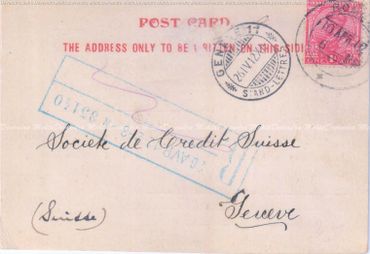An 1908 envelope addressed to Basle Chemical Works, Switzerland


A 1912 envelope addressed to Société the Credit Suisse


A 1912 Envelope from The Broach Industrial Cotton Spinning & Weaving Company


A 1930 Envelope from The Hotz Hotel
The Story
Hotz family (Mrs. F.E. Hotz & Robert Hotz) was not only the first family to own luxury hotels in India, but also, they were the first ones to have a hotel chain in the country. Mrs. F.E. Hotz was the primary force behind the hotel chain.
Hotel Cecil, Delhi, was established in 1904 and was owned by Hotz family. Civil Lines, in Delhi was where all English hotels were located in the first decade of 1900s. The three hotels that stood out were Maidens Hotel, Swiss Hotel and Hotel Cecil. Maidens Hotel was the favourite haunt of Edwin Lutyens, the chief architect of New Delhi. The Cecil was an exclusive hotel with about hundred rooms and a swimming pool. Today, St Xavier’s School stands where it once used to be.
Cecil Hotel, Shimla, stand at the location of erstwhile Tendrils Cottage, a regular abode, of Rudyard Kipling. The cottage was bought by Hotz family in 1902, renovated, and a Tudor-framed structure of Cecil Hotel arose at the site. Cecil, over a period of time was transferred to a newly created company, Associated Hotels of India. The story of how the legendary Mohan Singh Oberoi acquired the hotel thereafter needs no retelling; from a clerk with a salary of Rupees Fifty to acquiring the hotel from the than owner Mr. Clarke for Rupees Twenty-Five Thousand.
Wildflower Hall Hotel was the summer residence of Lord Kitchener of Khartoum. The building got burnt down and thus a new one was constructed. It was a favoured summer residence of Lord Ripon. In 1909, after Lord Kitchener returned to London, it was sold to Hotz family. Mrs. Hotz constructed a beautiful three storey hotel at the site. After independence, Himachal Pradesh Tourism Development Corporation ran the hotel. Another fire led to the destruction of the hotel. It was reconstructed by the Oberoi group. Today, it is a joint venture between Himachal Government and the Oberoi group.
Hotel Gables, Mashobra was a regular summer retreat of Lord Lutton, the Governor General and Viceroy of India (1876 - 1880). Today, Hotel Gables is owned by Gables Group active in hospitality, real estate and construction.
Lauries Hotel, Agra which was where the royalty and British gathered in British India has not kept pace with the times. It is a functional hotel but does not command the awe and respect that it once did.
Sources:
https://gablesindia.com/our-story/
https://www.tribuneindia.com/news/comment/cecil-where-it-all-began-563693/

A 1934 Envelope Addressed to Elgin Mills, Kanpur


Elgin Mills, Cawnpore
The Story
................................................
A 1938 Envelope from The Scindia Steam Navigation Company to its Shareholders


The Scindia Steam Navigation Company Ltd.
The Story
The company was founded in 1919. During its lifetime, the company undertook many acquisitions and mergers.
In 1932, it acquired Bengal Burma SN Company. The envelope above has a letter to shareholders wherein the company is distributing a dividend.
Mumbai Steam Navigation Company Limited and Kamal shipping Company Limited were amalgamated into the company in 1953 and 1973 respectively. The company's shipyard i.e., Scindia Shipyards, were nationalised in 1961 and rechristened as Hindustan Shipyards Limited.
In 1989 the company submitted a restructuring proposal and in 1991 a revised restructuring proposal was presented. However, the company could not revive its fortunes.
The company currently (2024) is undergoing winding-up proceedings.
A 1941 Envelope To Waco Aircraft Company from Tata Sons


Waco Aircraft Company
The Story
The Waco Aircraft Company’s roots trace back to WWI, when aviation enthusiasts Clayton J. Brukner and Elwood J. “Sam” Junkin met future collaborators while working for early aircraft manufacturers.
After experimenting with gliders and small planes, the group formed the Weaver Aircraft Company in Lorain, Ohio, in 1920, producing early models like the “Cootie.” In 1923, Brukner secured funding to reorganize as the Advance Aircraft Company, moving operations to Troy, Ohio.
Early designs like the Waco 9 and the best-selling Waco 10 established the company as a major U.S. aircraft builder. Demand surged, prompting the construction of a large factory in 1928, and in 1929, the business was officially renamed Waco Aircraft Company.
Throughout the 1930s, Waco introduced popular open- and closed-cabin biplanes, custom designs, and innovative features like tricycle landing gear. The company also produced military aircraft, including fighters and trainers, and became a leading supplier of “parasite fighters” for U.S. Navy airships. With the onset of WWII, Waco shifted heavily into military production, notably building over 1,600 troop-carrying CG-4A gliders in Troy, with tens of thousands more produced under license elsewhere, as well as manufacturing components for other aircraft.
Postwar, Waco attempted to re-enter the civilian market with a sleek pusher-prop monoplane, but surplus military planes made it unviable. The company pivoted to contract manufacturing and non-aviation products, but never regained its former dominance. Purchased in 1963 by Allied Aero Industries, Waco ceased aircraft production in 1965, and in 1969 its name rights were sold to Italy’s Siai-Marchetti. Though the original company closed, the Waco legacy endures as a symbol of innovation, craftsmanship, and adaptability in American aviation history
Source:
https://www.nationalwacoclub.com/waco-aircraft/waco-company/
A 1945 Envelope To Great West Permanent Loan Company from Bank of Bengal


The Great West Permanent Loan Company
The Story
The Great West Permanent Loan Company was founded by William Thomas Alexander in 1903 wherein he was the President and General Manager. He was also the Manager of the Imperial Canadian Trust Company.
In the fall of 1927, the Great West Permanent Loan Company and the Imperial Canadian Trust Company went into liquidation and charges were laid against Alexander and his brother, F. H. Alexander, that they conspired to defraud the companies. After one of the longest court cases in Manitoba history, both men were found guilty and W. T. Alexander was sentenced to three years in Stony Mountain Penitentiary.
A 1921 Envelope from The Great Eastern Tobacco Company

